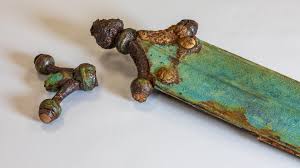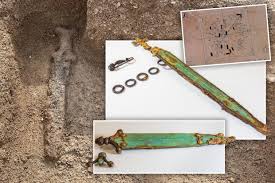2,300-year-old sword with swastikas unearthed at necropolis in France

Paris: Two 2,300-year-old swords discovered in a Celtic Iron Age necropolis in France “have few equivalents in Europe,” and one is decorated with tiny swastikas, the French National Institute of Preventive Archaeological Research (INRAP) reports.
Both swords were found intact in their scabbards. One of the swords has an ornate, copper-alloy scabbard designed to be worn at the waist. Several polished gems decorate the scabbard’s edges, and at least two of the gems have swastika designs.
Although swastikas are infamously tied to the Nazi regime and the atrocities of World War II, these ancient swastikas had different connotations. Swastikas were widely used in Mediterranean contexts, but these ornamental motifs were appropriated by the Celts in mainland Europe for their own use at the end of the fifth century and part of the fourth century B.C., Vincent Georges, an archaeologist associated with INRAP and manager of the necropolis excavation, told Live Science in an email. However, he is unsure of the swastika’s significance to the Celts.

Georges and his colleagues originally found the swords and other grave goods in 2022 at Creuzier-le-Neuf, a town that now has a population of just 1,500. But during the Second Iron Age (450 to 52 B.C.), Creuzier-le-Neuf was at the crossroads of territorial occupation by the powerful Celtic Arverni, Aedui and Bituriges tribes. The INRAP team excavated a roughly 7,000-square-foot (650 square meters) burial area there that housed over 100 graves. But due to the region’s highly acidic soil, no skeletal remains were found. A single cremation burial was discovered alongside a funerary vase with punched designs and painted bands.
Nearly half of the tombs had metal ornaments, including jewelry. Copper-alloy bracelets were the most common artifacts found in the burials, but the team also found 18 damaged brooches, including one decorated with a polished gem. The gem is set in a disc adorned with gilded silver and repoussé designs, or design patterns made by hammering the reverse side of the metallic sheet. It was created sometime between the late fourth and early third centuries B.C.
Another brooch has ocelli, or eyelike markings, a common decorative theme that was “fashionable among Celtic craftsmen” from the fifth and fourth centuries B.C., Georges said.





